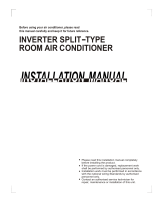
66
2. Drill a hole in the wall
3. Connective pipe installation
Wall
Indoor Outdoor
5-7mm
Fig.3
INDOOR UNIT INSTALLATION
1. Determine hole positions according to left
and right side of the installation plate. The hole
center is obtained by measuring the distance as
shown in the diagram of Fig.2.
2. Dirll the piping plate hole with 65mm hole-core drill.
3. Drill the piping hole at either the right or the left and
the hole should be slightly slanted to the outdoor side,
so that the outside end is lower than inside end,see Fig.3.
4. Always take steps to protect the pipe when drilling
metal grid,metal plate or the like.
Because the condensed water from rear
of the indoor unit is gathered in ponding
box and is piped out of room. Do not put
anything else in the box.
Fig.4
1. For the left-hand and right-hand piping,
remove the pipe cover from the side panel.
2. For the right back and left back piping,
install the piping as shown.
NOTE:
3. Attach the drain hose to the underside of
the refrigerant pipes with adhesive viny
tape.
4. Wrap the refrigerant pipes and drain hose
together with insulation tape.
5. Open the front panel, then open the wire
cover, connecting the cables.
6. Bundle the pipes, connecting cable, and
drain hose with tape securely, evenly as
shown in Figure on the right.
7. Pass them through the wall hole.
Both sides drainage structure is
standard. For both sides drainage structure,
it can be choosen for right, left or both sides
drainage connection. If choosing both sides
drainage connection, another proper drain
hose is needed as there is only one drain
hose offered by factory. If choosing one side
drainage connection, make sure the drain
hole on the other side is well plugged.
For 9k/12k models, if choosing left-hand
or left-back piping,please choosing left side
drainage connection. The connection of the
drain hose is supposed to be done by
qualified installer in case of water leakage.
Rubber plug
Fig.5















